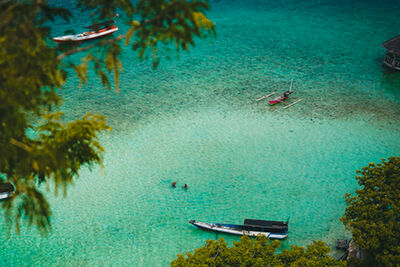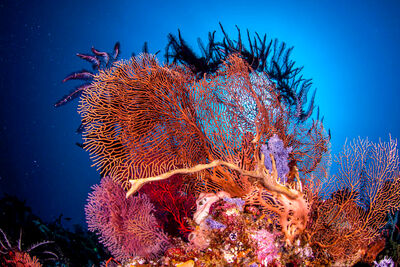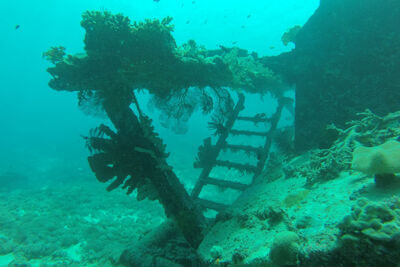From its vibrant marine ecosystem to its strategic role in history, the Java Sea is more than just a stretch of water - it's a living, breathing part of Indonesia's cultural and natural heritage. Whether you're a diver, traveller, history buff or just love fun facts about the world's oceans, there are some fascinating facts about the Java Sea to share. Read on to discover our top ten…
1. The Java Sea forms part of the Sunda Shelf in Southeast Asia
Let's start with location. The Java Sea is situated in the western Pacific Ocean, nestled between two major Indonesian islands - Java to the south and Borneo (Kalimantan) to the north. It forms part of the Sunda Shelf, a shallow part of the continental shelf of Southeast Asia, which plays a central role in the Indonesian archipelago's maritime geography.

2. The Java Sea forms part of the Sunda Islands group
The waters of the Java Sea are dotted with islands that form part of the Sunda Islands group, a vast archipelago that spans multiple countries. Most of the islands within the Java Sea belong to Indonesia, and they vary from bustling hubs like Java itself to more serene spots like the Thousand Islands (Kepulauan Seribu). Each island offers its own blend of culture and natural beauty, so a diving and island-hopping holiday here is one for the bucket list.
3. The Java Sea covers a whopping 120,000 square miles
Despite its vast expanse - covering approximately 120,000 square miles - the Java Sea is surprisingly shallow. Its average depth is only about 46 metres, making it one of the more accessible tropical seas for exploration, fishing and marine research.
4. More than 3,000 marine species can be found in the Java Sea
Of course, we can't have a Java Sea fact file without mentioning the characters. This sea is brimming with life; more than 3,000 marine species call the Java Sea home, including various molluscs, crustaceans, tropical fish and sea turtles. But keep your eyes open - among these colourful characters are stingers like the lion's mane jellyfish and the potentially dangerous Australian box jellyfish.
5. The Java Sea is home to several large marine species
As well as the smaller critters, in the Java Sea you might spot green sea turtles or see powerful swimmers like swordfish, sailfish and the rare knifetooth sawfish. Even the elusive giant catfish can be found navigating these shallow tropical waters.
6. Multiple species of reef sharks can be found in the Java Sea
Shark seekers, rejoice! The Java Sea is home to several reef shark species, including tiger sharks, blacktip reef sharks and the lesser-known but suitably fascinating white-spotted bamboo sharks. Keep your masked eyes out for a sighting of a small-eye hammerhead or a winghead shark - species that thrive in Indonesia's biodiverse marine environments.

7. Some of the most beautiful coral reefs in the region lie in the Java Sea
Some of Southeast Asia's most stunning coral reefs lie in the western Java Sea, particularly around the Karimunjawa Marine National Park, a protected area known for its reef diversity. Just north of Jakarta, the Thousand Islands are also teeming with life, from long-snouted seahorses and pipefish to vibrant azure damselfish and the camouflaged frogfish. You can easily escape the somewhat chaotic bustle of Jakarta life, and slip below the surface to explore the underwater city of coral reefs around the Thousand Islands. Sadly, many of the coral reefs have been harmed from an influx of tourism, so remember, when you dive around here, dive responsibly.
8. The formation of the Java Sea dates back to the last Ice Age
There is a pretty cool fact about the Java Sea - its formation is linked to the end of the last Ice Age. The Java Sea is located on the Sunda Shelf, a large and mostly flat shelf. The melting glaciers caused sea levels to rise and flood the Sunda Shelf, which, due to the relatively flat topography, meant that it was easily submerged, which is why the seabed is very flat! There were, of course, some higher points of the Sunda Shelf which formed the islands that we now know as Borneo, Java, Sumatra and Sulawesi.
9. The Java Sea was involved in World War II
During World War II, the Battle of the Java Sea took place in 1942, involving Allied forces from the United States, United Kingdom, Netherlands and Australia as they fought against the Japanese Navy who were trying to invade Indonesia. The Japanese forces won, leaving behind numerous sunken warships, many of which remain on the seabed today. In fact, this was one of the costliest battles for the Allied forces during WWII.

10. Due to its history, there are many wrecks on the Java Sea’s seabed
One of our favourite facts about the Java Sea is the amount of treasures that dot the seabed. Given its long history as a maritime trade route and battlefield, the Java Sea hosts many wrecks. Divers here can explore everything from massive hulks of steam-powered oil tankers, to relics from the commercial trade, and of course, ghostly wrecks from naval battles.
Cirebon wreck is one of the oldest, dating back to the turn of the first millennium. It was a merchant ship that was exporting lots of Yule yao - Chinese porcelains produced in the ancient region of Yue. This merchant vessel sank, taking with it thousands of bowls, platters and figurines of birds, deer and unicorns. This was discovered by a few local fishermen who - much to their surprise - found Chinese ceramics in their nets when fishing close to Cirebon - hence the name of the wreck.
Another popular wreck is the Indo, a wreck of a Panamanian ship which sank in 1955 around Kemujan island. Due to the relatively shallow waters, many of these wrecks have been scavenged by scrap metal seekers - in fact, some wrecks have completely disappeared. Despite this, there is still plenty to explore. And while they may tell stories of times long ago, these wrecks have since taken on new marine life, so be sure to admire the flourishing corals and try to spy some Pygmy seahorses alongside camouflaged frogfish.
















